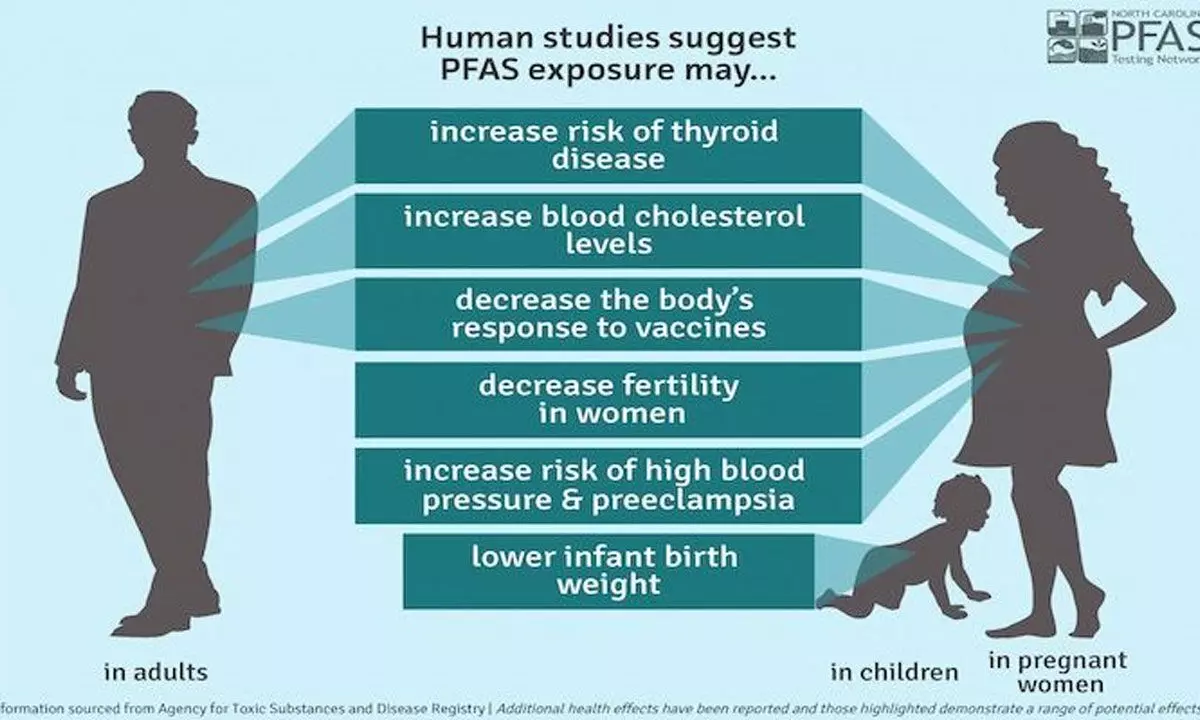Live
- IT sector stands out in challenging week for Indian equities
- DTO warns private buses against excess fare
- Mukkoti Ekadasi festivities on a grand scale
- Sri City celebrates Vaikuntha Ekadasi with spiritual grandeur
- US wildfires: Lower access to air conditioning ups emergency care risk, finds study
- PM Modi to inaugurate Z-Morh Tunnel on Jan 13, boosting all-weather connectivity in J&K
- Telangana Legislative Assembly Speaker Visits Tirumala on Vaikuntha Ekadashi
- Amazon.in Great Republic Day Sale: Exciting Deals on the Latest Smart TVs
- SPMVV signs MoU with TACA
- Joint action plan to avoid stampede incidents in future: Anam
Just In
Damaging effects of ‘forever chemicals’


PFAS accumulate in bodily tissues and fluids without breaking down in a perpetual self-sustaining fashion
Dublin: Since their inception in the 1940s, the so-called forever chemicals have woven themselves into the fabric of our modern world. But recently, they’ve been appearing in alarming news headlines about their damaging effects on our health. PFAS have, in fact, come under intense scrutiny due to new research showing their persistent nature in the environment and potential health impacts.
So, what are they and are they an issue in the UK and Ireland? Per- and Polyfluoroalkyl Substances (PFAS) are man-made chemicals, numbering approximately 4,700 variants. What makes them different is their formidable carbon-fluorine (C-F) bonds, renowned among scientists as the mightiest in chemistry. This stability makes them an important ingredient in many products. PFAS, in various forms, have played pivotal roles in creating oil- and grease-resistant food packaging, non-stick cookware, water- and stain-resistant textiles, and fire-fighting foams, to name a few. Their versatility has propelled them into our daily lives. The strength of their carbon-fluorine bonds is also what makes them resist breakdown by natural processes. Their longevity, often measured in centuries, has earned them the moniker of “legacy compounds”.
Forever chemicals
Their presence has been detected in worrying concentrations in drinking water, soil, air and even in Arctic ice. Recent scientific investigations have unveiled a concerning connection between PFAS exposure and damage to health, both in humans and animals. These effects include an increased risk of cancer, liver damage, compromised immune function, developmental disorders and hormonal disruption. The adverse health effects can be traced to their persistence within the human body. Unlike many substances that are metabolised and eliminated over time, PFAS accumulate in bodily tissues and fluids without breaking down. This accumulation creates a perpetual, self-sustaining cycle: PFAS contamination permeates rivers, soil and the food chain.
These chemicals find their way into the bodies of humans and animals, where they continue to accumulate over time. The mounting evidence of PFAS-related health risks has triggered global concern. Organisations such as the Stockholm Convention on Persistent Organic Pollutants have set their sights on imposing stricter regulations on PFAS use within the European Union. There is still a lot we don’t know about the long-term health consequences of PFAS exposure, but the increasing global concern is indisputable. In the UK and Ireland, PFAS contamination infiltrates everyday consumer products and industrial processes. In 2019, the UK Environment Agency’s screening consistently identified PFAS in surface water samples, with PFOA and PFOS found at 96 per cent of the sites they surveyed.
The presence of heightened PFAS concentrations signifies that none of England’s rivers meet the “good chemical” status criteria established by the Water Framework Directive. The Chief Scientist’s Group report identified military and civilian airfields, landfills and wastewater treatment facilities as the likely sources of PFAS contamination. A pressing issue in Europe and the UK is the absence of standardised regulations regarding these forever chemicals. Only two of the most prevalent PFAS variants, PFOA and PFOS, are currently monitored in the UK. The Environment Agency’s 2021 report underscored gaps in the environmental monitoring of PFAS in British waters. These gaps include a lack of toxicology information about how PFAS are released throughout the life cycle of consumer products and drinking water, for instance recycling and waste disposal practices. This makes it difficult to properly assess the risks forever chemicals may pose. The solution
It’s important to acknowledge that certain PFAS play a crucial role in drug formulations and medical uses. But the lack of research, testing, and public awareness surrounding these compounds has allowed this issue to persist for too long, mostly due to the useful properties of forever chemicals. The intricacies associated with PFAS mean we need a holistic approach involving research to discover new chemical compounds that do not harm the environment and human health.
While the solution is complex, it is undoubtedly achievable. We need stringent regulations, more research and a global effort to eliminate PFAS. The payoff is worth it – a safer and healthier future for both our planet and its inhabitants. (The Conversation)

© 2025 Hyderabad Media House Limited/The Hans India. All rights reserved. Powered by hocalwire.com






